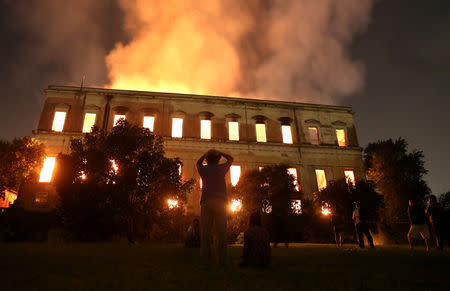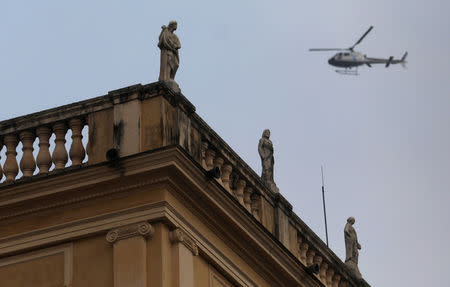Tensions flare after fire destroys Brazil museum in 'tragedy foretold'
By Gabriel Stargardter
RIO DE JANEIRO (Reuters) - Anger smoldered in Brazil on Monday after a fire destroyed the National Museum, a cherished historical repository that lacked a sprinkler system and which had suffered years of financial neglect, making its destruction a "tragedy foretold."
Outside the entrance to the elegant park housing the 200-year-old former Imperial Palace, police in riot gear shot tear gas into a small, angry crowd that tried to enter, live TV images showed. Later, police granted access to the site's perimeter, which protesters surrounded in a symbolic "embrace."
The rumbling tensions reflect anger over the destruction on Sunday of the much-loved yet dilapidated museum, which suffered from declining federal funding. It stirred emotions in Brazil, whose angry electorate is reeling from a frail economy, widespread graft and rising violence ahead of an unpredictable presidential election in October.
"Our community is very mobilized, and very indignant," said Roberto Leher, rector of the Rio de Janeiro federal university, which administers the museum. "We all knew the building was vulnerable."
Brazil's culture minister Sergio Leitao told the Estado de S.Paulo newspaper the blaze was likely caused by either an electrical short-circuit or a homemade paper hot-air balloon that may have landed on the roof. Launching such balloons is a long-held tradition in Brazil and they routinely cause fires.
Both possibilities were being considered, Culture Ministry spokeswoman Roberta de Oliveira Ribeiro said in an email, but the cause would not be known until an investigation was completed. The Rio de Janeiro federal university did not immediately respond to a question on whether the museum was insured.The museum's pastel-yellow facade remained standing after the blaze, but a peek inside its giant windows revealed a roofless interior of blackened hallways and charred beams. Every so often, firemen emerged with a pot or a painting they had managed to rescue.
The museum's vice director, Luiz Duarte, told Globo TV the institution had been neglected by successive federal governments. He said a 21.6 million-real ($5.23 million) financing plan with the state-run development bank BNDES announced in June included, ironically, a plan to install modern fire protection equipment.
The Rio fire department's commander, Roberto Robadey, said the hydrants outside the building were dry when firefighters arrived, forcing them to turn to a nearby lake and tanker trucks for water.
"Yesterday was one of the saddest days of my career," he said.
FRAGILE CULTURE
The museum is not the first to burn down in Brazil, where public money for cultural projects has been drying up after a deep recession. In 2015, for example, a blaze destroyed the prestigious Museum of the Portuguese Language in Sao Paulo.
In 2016, President Michel Temer was forced to reinstate the Culture Ministry after an outcry from some of the country's top artists over his policy to fold it into the Education Ministry to save money.
On Monday, his office said he had met with representatives from major Brazilian companies and banks to look into ways to help rebuild the museum "as soon as possible."
Education Minister Rossieli Soares told reporters outside the burned-out building on Monday that the federal government would spend an initial 15 million reais, in two separate installments, to restore the structure and rebuild its collection. He added that Brazil would seek international help, and was already in discussions with UNESCO.
The museum's decline did not happen overnight, said Renato Rodriguez Cabral, a teacher in the geology and paleontology department.
"This was a tragedy foretold," Cabral said, hugging distraught students and coworkers who poured into the site on Monday. "Successive governments would not provide funds, they would not invest in infrastructure."
Between 2013 and 2017, the National Museum in Rio's federal funding fell about a third, to 643,567 reais, according to official budget data. The funding cuts were particularly acute this year, with the museum receiving just 98,115 reais between January and August.
Late last year,, after a termite attack shuttered a room hosting the bones of the Maxakalisaurus dinosaur, the National Museum was forced to turn to a crowdfunding site to seek funds for reopening the exhibit.
It raised nearly 60,000 reais, almost double its goal.
The National Museum's collection ranged from archeological finds to historical memorabilia.
The museum, which is tied to the Rio de Janeiro federal university and the education ministry, was founded in 1818 and housed several landmark collections, including Egyptian artifacts and the oldest human fossil found in Brazil.
The destruction of the building, where emperors once lived, was an "incalculable loss for Brazil," Temer said in a statement.
His office did not respond to requests for comment on widespread allegations of neglect.
($1 = 4.1310 reais)
(Reporting by Gabriel Stargardter; Additional reporting by Marcela Ayres; Editing by Brad Brooks, James Dalgleish and Jonathan Oatis)












